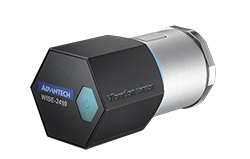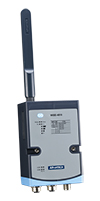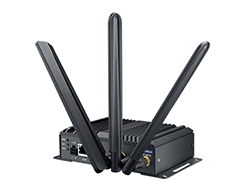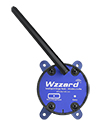How LoRa opens new opportunities in the Industrial IoT (IIoT)
Yuan Lee and Tim Taberner, from Advantech, present an introduction to wireless technologies and their applications in factory automation.
In the past five years, wireless technology has been an important topic in the industrial marketplace. There are several key reasons why interest and adoption has grown:
1. Cost savings on overall engineering and installation: Wireless coverage doesn’t need physical cabling to each and every end point or machine that needs connectivity and monitoring. This can significantly reduce the costs and complexities of installation, enabling data to be collected from points which would otherwise be uneconomic to monitor.
2. Flexibility when future expansion is needed: A well-planned wireless deployment allows expansion or redeployment of infrastructure easily and quickly with zero down-time.
3. The value of data: Mobility, Industry 4.0, Internet of Things, factory digitalisation and OEE (Overall Equipment Effectiveness) monitoring – the key input to these applications is data. Data which previously was of minor interest is becoming increasingly valuable for optimising workflows, saving costs and predicting future needs.

Above: WISE-2410 is a LoRaWAN wireless conditional monitoring sensor integrated with ARM Cortex-M4 Processor, LoRa transceiver, 3-axis accelerometer and temperature sensor
However, what type of data is valuable? What is the cost for collecting data? These are the two key factors that companies should focus on.
What is the right wireless technology for my needs?
Every wireless technology has different advantages and disadvantages. Specifying which technology can provide the correct solution depends on multiple factors. These factors can include:
- Cost structure (infrastructure, wireless licensing models)
- Data transmission size and frequency
- Time sensitivity
- Scale of the application
- Required coverage (local, national, worldwide)
- Power availability and requirements
- Network topology
As such, there is no single wireless technology that can fit into every application scenario. Due to their wide adoption in other areas of society, over the past ten years, the most popular wireless technologies for monitoring and control have been cellular, WiFi, and private radio.

Above: WISE-4610 features a wireless sensor node based on LoRa network technologies targeting outdoor applications
Cellular technology is dominant in applications that have concerns about the geographic coverage and connection volume. For example, both the car industry and fleet management require wireless technology in the vehicle that can communicate with central service points around a country or even cross-border. Cellular technology (3G/LTE) is currently the best wireless technology for these types of markets.
WiFi technology is the most common wireless technology in both consumer and industrial applications. There is no license fee and, thanks to adoption in consumer and residential application, the component cost and the technology entry barrier is low. WiFi is the most popular wireless technology for factory automation and machine builders, markets which require an easy to implement and cost-effective local area wireless network.

Above: The WISE-6610 is a high-performance LoRaWAN gateway with reliable connectivity options for industrial environments and LoRaWAN protocol support
Private radio systems have been used extensively in the utilities and oil and gas sectors for over 30 years. In these installations all of the radio equipment, including the antenna masts and other infrastructure, is owned and operated by a private company, normally the same company who own the assets being monitored. They involve substantial capital expenditure to deploy and significant operating expenditure to operate and maintain. As such they are slowly being replaced with more up-to-date and open technology. They do, however, provide the benefits of guaranteed bandwidth and low latency.
IIoT wireless technologies continue to be introduced to the market. Some of them are targeted on issues that current wireless technology cannot address. In this white paper however we will focus on the new LoRa technology and its application in IIoT.
LoRa and how it works
LoRa is a low power radio technology that is intended for use in applications where the geographical coverage is large and the data volumes and rates are relatively small. The key feature of LoRa is the very low cost of deployment and operation. The radio technology is available in silicon at sufficiently low prices to justify its direct inclusion within even the simplest of sensors and uses sufficiently small amounts of power to allow these sensors to operate from battery supplies for many years, subject to the operating scenario. This low power technology also allows the use of various forms of energy harvesting.
The first thing to understand is that the term LoRa refers only to this underlying radio technology and does not define any of the data payload or naming formats needed to move information between locations. These formats are layered above the underlying radio system and there are basically two varieties.

Above: The Wzzard intelligent wireless sensor platform creates a complete, quick and easy connectivity stack
1. Vendors design their own proprietary protocol. These systems, known as LoRa Proprietary systems, originally had an advantage in that they allowed vendors to bring products to market before standards were fully established. Even after standardisation they still have a place in specialised applications requiring highly optimised or niche features within a system. However, they suffer from the major disadvantage that users are locked in completely to the vendor’s ecosystem of sensors, gateways and enterprise services, with little or no option to integrate third-party sensors or devices. They are also generally incompatible with public LoRa infrastructures and only available on private networks.
2. LoRaWAN. To address the issue of openness and interoperability between sensors and gateways, a protocol layer has been defined by the LoRaWAN alliance which defines the naming and payload conventions within a system. This means that any LoRaWAN sensor should communicate with any LoRaWAN gateway, allowing users to select the best of breed options for each measuring and transmission point, or to buy a system from a single vendor safe in the knowledge that it can be expanded using other vendors’ devices in the future.
LoRaWAN can be deployed on both public and private networks. In a public network, all of the gateways and the cloud infrastructure are provided by a third-party. Users may connect LoRaWAN sensors to the network and can access the resulting data through the third party’s portal (known as the network server in the LoRa architecture). It’s similar in concept to a cellular network where users connect their phones to a particular network providers’ service, in return for a regular fee. It also suffers similar drawbacks to a cellular system, where a user has no real indication or control over how many third parties are sharing the same infrastructure, and therefore, how well the system performance will be maintained.
An interesting alternative in the industrial world however, is the ability for users to easily deploy their own networks of gateways to create their own private system. In this set up, their data is never placed on a shared infrastructure. Users can recreate the classic LoRaWAN architecture, with a network server located in their data centre. However, it is becoming increasingly popular to provide some edge processing in the gateways to convert the LoRaWAN data into something more easily consumed by IT systems, such as MQTT or REST, and to provide event processing and aggregation before onwards transmission.
Practical use cases?
Wireless technology is often viewed as an ‘IT technology’ by industrial customers. The most common questions requiring consideration are around how to utilise this technology for OT systems - to maximise efficiency; to provide real-time data; and to deliver a quantifiable return on investment. As examples, here are three case studies of actual LoRa applications.
Factory Automation
The problem: The customer needed to recover data from remote assets. The assets already had intelligent sensors connected to them, capable of providing information on gas, water and electricity consumption via a Modbus interface, but the sensors were several kilometres away from the control room, with a lot of concrete walls, buildings and other obstructions in between. The cost of installing cables or conventional radios to recover the information was prohibitively high. Also, the control room system worked using Modbus-TCP and required protocol conversion between the sensors and the host SCADA.
The solution: These problems were overcome by deploying a Wzzard LoRaWAN node capable of locally integrating the Modbus data, and transferring this via a private LoRaWAN network to a LoRaWAN private gateway. The gateway was able to recover the data recovered via LoRaWAN and serve this to the SCADA system by presenting it in Modbus-TCP format.
The benefits: Before implementing this solution, the factory had been using a manual data recovery scheme from the sensors. This cost labour resources and introduced a possible source of error into the system. Eliminating these issues has significant benefits in a factory environment where users often have large installed bases of legacy PLCs, RTUs, sensors and other Modbus devices acting in isolation where the data has value to the organisation but is not economically recoverable.

Above: A LoRaWAN sensing network
Production forecasting
The problem: This case study is from the agriculture industry. This customer needed the ability to collect raw environmental data from several industrial scale greenhouses, but the cost of cabling around the sites was uneconomic. In addition, many of the sites were in remote locations without a land line connection over which to offload the data.
The data they needed included climatic elements such as wind speed and direction, temperature, rainfall and solar radiation, which could be taken from a single measuring point for the whole greenhouse. They also needed soil status information taken from a number of points around the structure, with a typical greenhouse occupying an area of around 3km².
The solution: Cabling costs were eliminated by using Wzzard LoRaWAN nodes to collect the soil status information from soil sensors, and a WISE-6610 LoRaWAN private gateway. The gateway provided a number of functions. First, it created the private LoRaWAN network and recovered the information sent by the Wzzard LoRaWAN nodes. Secondly, it interfaced directly to the climatic sensors and recovered this information via a local communications interface. Finally, it handed the data off via a 4G LTE cellular connection, meaning that the solution could be deployed anywhere that cellular coverage existed.
The benefits: This customer was able to improve production and logistic efficiency and can now provide production forecasting insight from a greenhouse environment to their clients using big data analysis.
Environmental Monitoring
The problem: An internal use of Advantech technology. Advantech European Service Campus had a requirement to collect environmental data from around the site, including both offices and warehouse facility. It was essential that any solution could work within a steel and concrete construction building, with a large steel racking space and constant movement of people and objects within the environment. It was also essential that a battery powered solution could be deployed for the monitoring points, as mains power was not always readily available.
The solution: Advantech were able to source the necessary LoRaWAN sensors from third parties, measuring temperature and humidity, door opened/closed status, lighting levels, PIR for room occupancy etc. and, because Advantech support the open LoRaWAN protocols, the company were able to recover information over a private LoRaWAN network created by a WISE-6610 gateway. Once recovered by the gateway, the data is sent on to a SCADA package providing visualisation and data archiving.
The benefits: This set up gives the office administrators a complete overview of the environmental conditions throughout the campus and allows them to react as needed.










